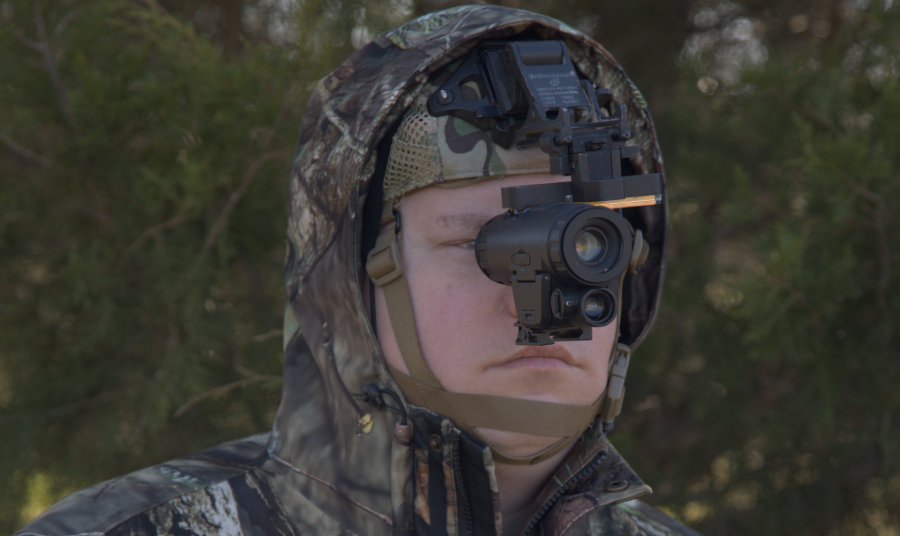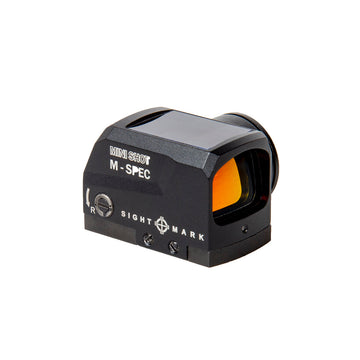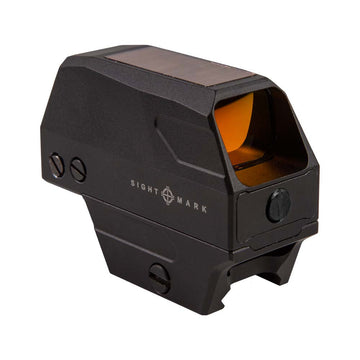One does not simply expect to be accurate with iron sights if one is shooting at night. If you want to use your night vision device with a pistol or rifle in a dynamic shooting environment, you’ll need to find some way to accurately see where you’re aiming at, since lining up your front sight and your rear sight aperture is pretty much impossible if you’re wearing a night vision device. NVDs are designed to focus on mid to long range objects, making the rear sights appear blurry and out of focus.
Why Red Dot Sights Are Essential for Low-Light Accuracy
Practically speaking, you’d need to invest in a quality red dot or IR laser to operate in low-light or no-light environments. Whether you're hunting at dusk or defending something in the dark, this pairing is a necessity.
How Red Dot Sights Work with Night Vision Monoculars
Red dot sights project a crisp reticle that’s easy to acquire, making them the go-to for fast targeting. When used with a night vision monocular, the red dot remains visible, but the mechanics shift slightly. Night vision amplifies available light, meaning any illuminated reticle can dominate your view. Thankfully, modern red dot sights like the Sightmark Wolverine often come with night vision-compatible settings, dimming the reticle to a level that won't overwhelm the monocular's sensors.
Instead of looking directly through the red dot with both eyes, you’ll typically align the monocular on your dominant eye and aim your red dot exclusively with that eye. The monocular captures and amplifies the environment, while your off-eye remains uncovered, providing spatial awareness.
Top Red Dot Sights for Night Vision Shooting
Adapting Your Aim with Night Vision Gear
When using night vision monoculars, your aiming technique changes. Unlike traditional two-eyed shooting, your dominant eye does most of the work. This requires a slight adjustment in head positioning to align the monocular, red dot, and target.
Tips for Accuracy
- Practice alignment: Mount your monocular and aim through your red dot sight. The more time you spend training, the more natural it will feel.
- Embrace the “both-eyes-open” method: While your monocular-equipped eye handles aiming, your other eye contributes situational awareness, helping you maintain balance and avoid tunnel vision.
- Adjust your reticle brightness: Too bright, and your reticle can bloom, obscuring details. Too dim, and it might get lost in the shadows.
Why Use a Monocular on Just One Eye?
By keeping one eye unaided, you retain some level of natural vision, which is critical when transitioning between lit and unlit areas.
This approach also minimizes disorientation. Imagine stepping out of complete darkness into a brightly lit environment—if both eyes were behind night vision, the sudden brightness could leave you momentarily blinded. With one eye unaided, you can adapt quickly to changing light conditions, maintaining awareness and control.
Additionally, monoculars are lighter, more compact, and more affordable than their binocular counterparts, making them a popular choice for civilians on a budget who value versatility and convenience.
Why Bother Pairing Red Dots with Night Vision?
So, why go through the effort of pairing a red dot sight with a night vision monocular? The benefits are plenty:
- Improved Mobility: Night vision monoculars, as opposed to riflescopes, allow you to navigate uneven terrain or obstacles while keeping your gear lightweight and streamlined.
- Versatility: With a monocular and red dot setup, you’re not just limited to shooting. You can scout the area, track game, or identify threats without switching devices.
- Cost-Effectiveness: Compared to high-end night vision scopes, monoculars paired with red dots are more budget-friendly while still delivering exceptional performance.
- Situational Awareness: By keeping one eye unaided, you maintain an essential sense of your surroundings, a critical advantage in dynamic environments.
Tips for Getting Started
- Choose Compatible Gear: Look for a red dot sight with night vision settings, like the Sightmark Wolverine or Mini Shot series, and pair it with a quality night vision device like the Wraith 4K Monocular.
- Optimize Mounting: Your red dot should be mounted high enough to align easily with your monocular. Consider a riser if needed.
- Practice, Practice, Practice: Familiarize yourself with your setup in controlled conditions before heading out. Get comfortable with aligning the red dot and monocular under different light scenarios.
- Mind the Batteries: Both devices rely on power, so always carry spares. Nothing’s worse than having your gear die on you in the field.
Conclusion: Red Dot Sights Are Night Vision's Best Friend
Pairing red dot sights with night vision monoculars is a highly effective way to adapt to low-light environments without sacrificing mobility, accuracy, or awareness. With practice, you’ll master this synergy and gain an edge in nighttime shooting. Whether you’re chasing game under the stars or conducting dangerous nighttime patrols, this dynamic duo has you covered.
To shop Sightmark's night vision devices, click here.
To shop Sightmark's red dot sights, click here.
Frequently Asked Questions
Why are red dot sights essential for low-light accuracy?
Red dot sights are essential for low-light accuracy because they provide a crisp reticle that is easy to acquire, making them ideal for fast targeting in low-light or no-light environments.
How do red dot sights work with night vision monoculars?
When used with a night vision monocular, the red dot remains visible but is dimmed to prevent overwhelming the monocular's sensors. The monocular is typically aligned on the dominant eye, while the red dot is aimed exclusively with that eye.
What are some top red dot sights for night vision shooting?
Some top red dot sights for night vision shooting include the Ultra Shot R-Spec Reflex Sight, Mini Shot M-Spec M2 Solar, and Volta Solar Red Dot Sight, each offering different features for accuracy in low-light conditions.
How does aiming technique change when using night vision gear?
When using night vision gear, your aiming technique changes to rely more on your dominant eye. This requires adjusting head positioning to align the monocular, red dot, and target effectively.
What are some tips for accuracy when using night vision gear with a red dot sight?
Some tips for accuracy include practicing alignment with your monocular and red dot sight, embracing the 'both-eyes-open' method for situational awareness, and adjusting the reticle brightness to prevent blooming or getting lost in shadows.







